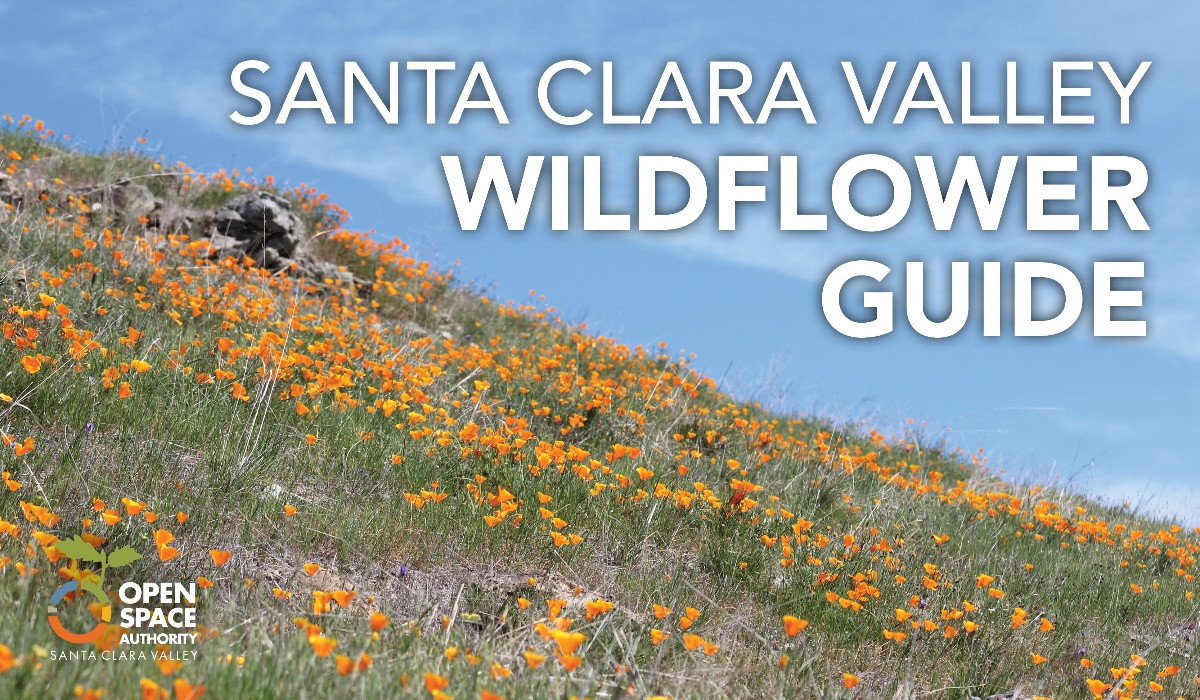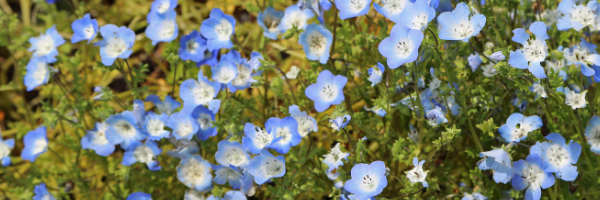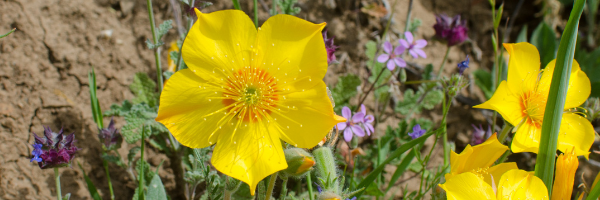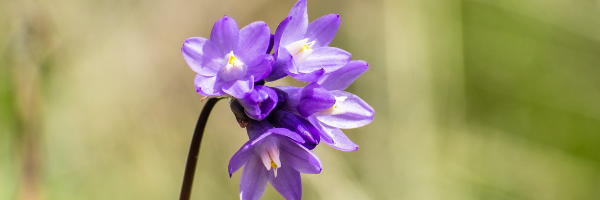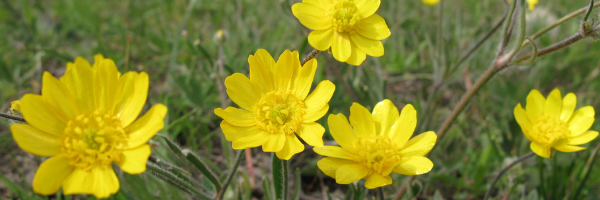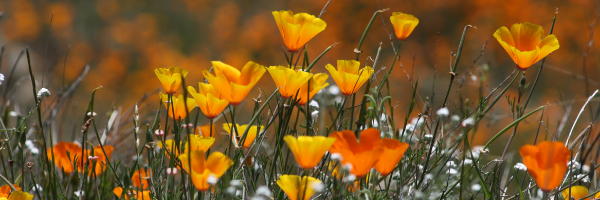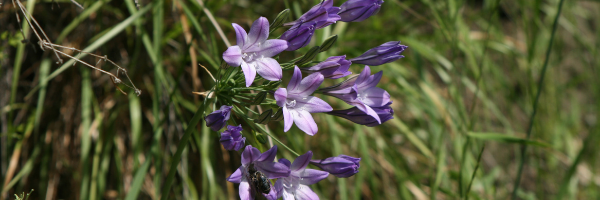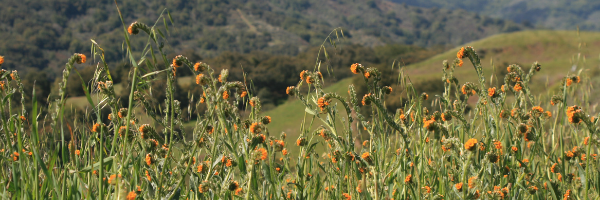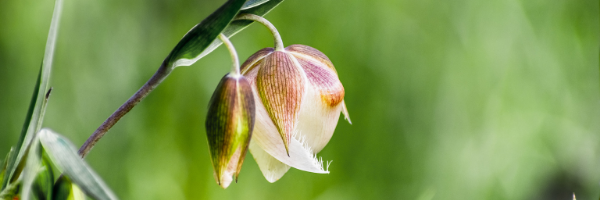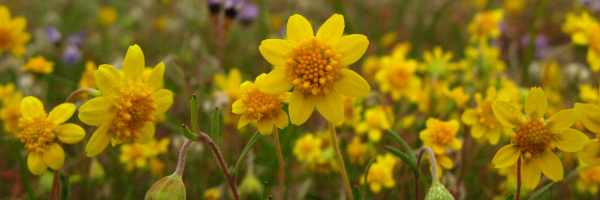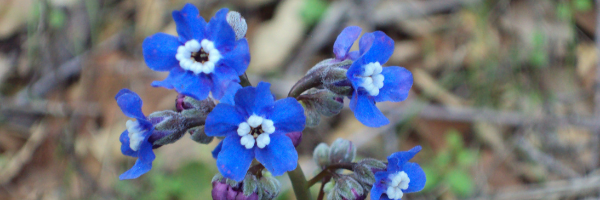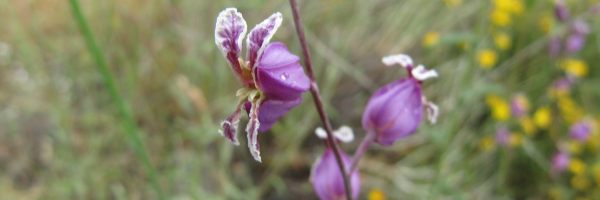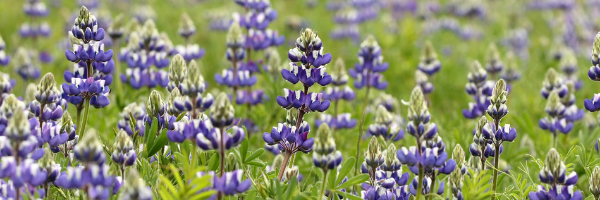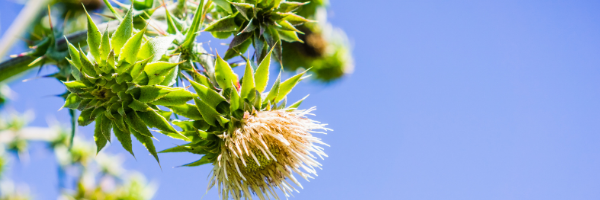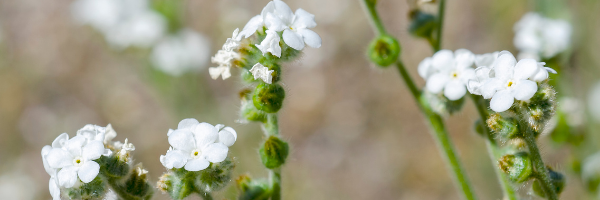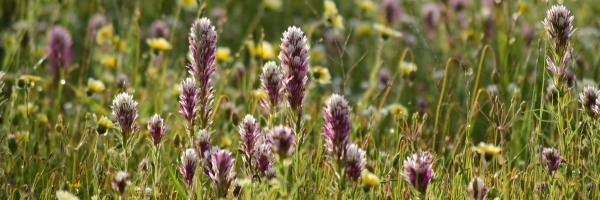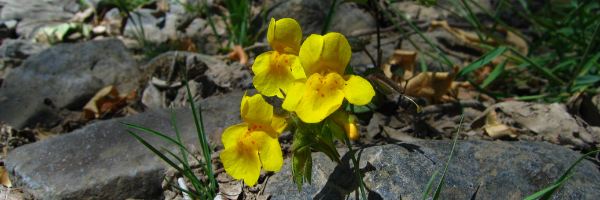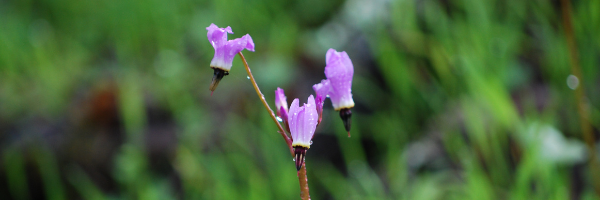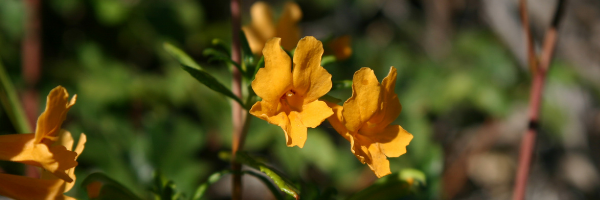Spring in the Santa Clara Valley is the most colorful time of year! Open spaces provide habitat for many diverse species of native flowers, and every spring, you can find them across our region's hills, valleys, and woodlands.
From lilies to lupine, we’ve compiled this list of 24 flowers you can find in your open space preserves this spring. Happy Wildflower Season!
Please note that “Best time to find” may vary between years; bloom times for all flowers can be affected by variables like rainfall, temperature, elevation, and even wildfire in previous years.
Remember: Take only photos and never pick or disturb wildflowers to preserve the trailside beauty for other visitors as well as the pollinators and other wildlife that rely on this habitat. We thank you for always staying on the trail for your safety and to protect the sensitive plants and animals that live in the preserves.
1. Baby blue eyes
Nemophilia menziesii
True to the name, baby blue eyes are known for their bright blue, five-petaled flowers with white centers. You can find them growing in clusters in meadows, grassy slopes, and canyons. This flower is easy to grow, and you are just as likely to spot it in gardens as in open spaces.
- Best time to find: Late winter through late spring
- Preserves: Coyote Valley, Rancho Cañada del Oro
2. Blazing star
Mentzelia lindleyi
Blazing star is a cheerful-looking wildflower that blooms in late spring. Unlike most other flowers, blazing stars open in the late afternoon, stay open all night, and close by noon the following day. Appropriately, another name for them is “evening star.” Blazing star’s large yellow blossoms can measure up to three inches wide, and a single plant may have 25 to 35 flowers. Blazing stars grow in bright sunny areas with sandy or rocky soil.
- Best time to find: Late spring and early summer
- Preserves: Rancho Cañada del Oro, Sierra Vista
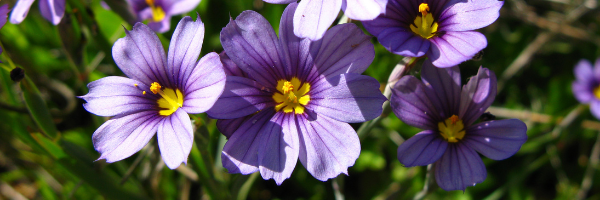
3. Blue-eyed grass
Sisyrinchium bellum
Blue-eyed grass grows throughout California. Its small, 1-inch flowers have six blueish-purple petals and a yellow center. As the name suggests, blue-eyed grass has thin, grass-like leaves, but is technically not a grass species (it’s a member of the iris family). It grows well in moisture and can be found in open, grassy areas as well as woodlands.
- Best time to find: Spring
- Preserves: Coyote Valley, Máyyan 'Ooyákma – Coyote Ridge, Rancho Cañada del Oro, Sierra Vista
4. Blue dicks
Dipterostemon capitatus
Blue dicks, also known as wild hyacinth, cluster-lilies, and school bells, are lavender flowers that grow in grassy areas from Oregon all the way to Mexico. The physical structure of these flowers allows them to be resilient to environmental stressors like drought, fire and predation. And good thing, too! Blue dicks are rich in carbohydrates, making them a valued food source for animals.
- Best time to find: Spring
- Preserves: Coyote Valley, Máyyan 'Ooyákma – Coyote Ridge, Rancho Cañada del Oro, Sierra Vista
5. Buttercups
Ranunculus californicus
Buttercups are easily identified by glossy, yellow flowers that have 9 to 17 petals each. Don’t let their tasty-sounding name fool you! – the buttercup is toxic when ingested and can even irritate the skin. Look for them in bright, sunny areas before they go dormant in the late summer.
- Best time to find: Late winter through summer
- Preserves: Coyote Valley, Máyyan 'Ooyákma – Coyote Ridge, Rancho Cañada del Oro
6. California golden violet
Viola pedunculata
California golden violets, also known as “Johnny jump-ups" or “wild pansies,” are low-growing wildflowers with heart-shaped yellow petals. You can find them on open, grassy slopes, meadows, and oak woodlands - they grow in clumps or colonies.
- Best time to find: Mid-winter through mid-spring
- Preserves: Coyote Valley, Máyyan 'Ooyákma – Coyote Ridge, Rancho Cañada del Oro, Sierra Vista
7. California poppy
Eschscholzia californica
The vibrant blooms of the California poppy are one of the first signs of spring in the Santa Clara Valley! This native species became the state flower in 1903. California poppies open only in sunny weather, displaying blooms in brilliant shades of orange, yellow, and even red. You can find them in grassy, sun-exposed habitats across our state. Early Spanish travelers called the plant “copa del ora” or “cup of gold.”
- Best time to find: Late winter through late summer
- Preserves: Coyote Valley, Máyyan 'Ooyákma – Coyote Ridge, Rancho Cañada del Oro, Sierra Vista
8. Ithuriel's spear
Triteleia laxa
Ithuriel spears love heavy soils, open forests, foothill woodlands, and grasslands. Their purple or blue flowers bloom on small stalks atop a tall, leafless stem in early summer and can grow up to two feet tall.
- Best time to find: Early summer
- Preserves: Coyote Valley, Rancho Cañada del Oro, Sierra Vista
9. Fernald’s iris
Iris fernaldii
The Fernald's iris is one of several species of iris native to California. It has gray-green leaves and pale yellow or creamy white flowers with gray or purple veins (purple Fernald’s irises are a rare variety). Look for this flower in shady woodlands.
- Best time to find: Mid- to late spring
- Preserves: Rancho Cañada del Oro
10. Fiddleneck
Amsinckia menziesii
The fiddleneck is a member of the forget-me-not family. Each flowering stalk ends in a curly whorl of yellow-orange flowers that resembles the head of a violin or fiddle - giving it the name of fiddleneck! The fiddleneck has a bit of a complicated reputation; the rapid growth of this wildflower can cause problems for livestock and agriculture, earning its other name of “rancher’s fireweed.” However, this native flower is important for many birds, butterflies, bees, and other insects. The Lawrence’s goldfinch, painted lady butterfly, and honeybees are just three species that depend on the fiddleneck for food. Note for equestrian visitors: if your horse is grazing along the trail, avoid Fiddleneck, as they are very toxic to horses.
- Best time to find: Late winter through late summer
- Preserves: Coyote Valley, Máyyan 'Ooyákma – Coyote Ridge, Rancho Cañada del Oro, Sierra Vista
11. Globe lily
Calochortus albus
The globe lily is an enchanting flower with delicate, nodding blossoms that range in color from pearly white to deep pink, with greenish tinges. They are also known as “fairy lanterns” and “satin bells.” You can find globe lilies in the shady woodlands of our open space preserves - look for these magical flowers before they go dormant for the summer!
- Best time to find: Spring
- Preserves: Coyote Valley, Rancho Cañada del Oro
12. Goldfields
Lasthenia californica
Goldfields earned their name by blanketing open spaces with seas of bright, buttery yellow flowers. Goldfields can thrive in poor soils, including on the serpentine soils found in Coyote Ridge Open Space Preserve and along spring pools in the Sacramento Valley. It has reddish stems, and the flowers extend three to seven inches high. Goldfields are pollinated by insects, including small flies and by native bees. Like many other native plants, goldfields face threats from invasive species, development, and climate change; its splashy blooms depend on ample winter rains.
- Best time to find: Spring
- Preserves: Máyyan 'Ooyákma – Coyote Ridge, Rancho Cañada del Oro
13. Western hound's tongue
Andelinia grandis
Hound's tongue is a shade-loving species of wildflower named for its broad, tongue-shaped leaves. Each of its flowers has five bright blue petals surrounding a distinct white ring. You can find this member of the forget-me-not (or Boraginaceae) family in shady woodlands.
- Best time to find: Late winter through spring
- Preserves: Coyote Valley, Rancho Cañada del Oro
14. Most beautiful jewelflower
Streptanthus albidus ssp. peramoenus
Jewelflowers are thin and pale green with bristly bases and able to grow up to three feet tall. The white and pink urn-shaped flowers alternate every inch from the end of the stem and have frilly-edged petals. There are 40 different species of jewelflowers, including the "most beautiful jewelflower,” which is only found in California. The most beautiful jewelflower is rare, but you might be lucky enough to find it on serpentine soils in open areas such as chaparral, valley grassland, and foothill woodlands.
- Best time to find: Mid-spring through mid-summer
- Preserves: Máyyan 'Ooyákma – Coyote Ridge, Rancho Cañada del Oro
15. Lupine
Lupine sp.
Lupine is a short wildflower that often grows in large patches, creating seas of purple in open space preserves. Each blossom has a white splotch, which directs insects and hummingbirds to the pollen. The name “lupine” comes from the Latin word for "wolf” (the origin of this name is unclear, but it may have to do with the beliefs that lupine killed livestock and/or depleted the soil of nutrients). Look for lupine in grasslands and on sunny slopes.
- Best time to find: Spring
- Preserves: Coyote Valley, Máyyan 'Ooyákma – Coyote Ridge, Rancho Cañada del Oro, Sierra Vista
16. Mariposa lily
Calochortus sp.
The mariposa lily is a bell-shaped flower with curved petals and intricate patterns. Mariposa means “butterfly” in Spanish – perhaps in reference to this flower’s wing-shaped petals with patterns that resemble a butterfly’s markings? There are over 60 species of mariposa lilies worldwide, with over 50 that are native to California (including the butterfly mariposa lily, yellow mariposa lily, and clay mariposa lily). Insects and other pollinators love these flowers! You can usually find small beetles or other bugs hanging out in mariposa lilies.
- Best time to find: Late spring and early summer
- Preserves: Coyote Valley, Máyyan 'Ooyákma – Coyote Ridge, Rancho Cañada del Oro, Sierra Vista
17. Mount Hamilton thistle
Cirsium fontinale var. campylon
The rare Mount Hamilton thistle is only found in a few areas of California, including Santa Clara Valley. It grows in moist, serpentine soil, especially near streams, springs of water, and other wet areas. Like other thistle varieties, the Mount Hamilton thistle has a thick, upright stem and has spiny-lobed or toothed leaves. Its white flowers have many thin petals and are perpetually nodding forward on their stalks. Its phyllaries, the leaf-like structures below the flower heads, are large and curved backwards. The Mount Hamilton thistle is threatened by many human-caused factors, including urban development, trampling, and the introduction of non-native species.
- Best time to find: Early spring through mid-autumn
- Preserves: Máyyan 'Ooyákma – Coyote Ridge
18. Mule's ears
Wyethia sp.
This native flower gets its name from the large leaves that resemble the ears of a mule. Its big yellow flower heads sit atop stems up to 2 feet tall. Mule's ears belong to the Asteraceae family, along with sunflowers, daisies, tidy tips, dandelions, and most thistles. Native animals LOVE mule's ears. Pollinators are attracted to the flower heads, and the large, nutritious seeds are eaten by birds, burrowing rodents, and insects. Look for them in sunny meadows and at the edges of woodlands. Like most flowers in Asteraceae, they love the sun!
- Best time to find: Early spring through summer
- Preserves: Coyote Valley, Rancho Cañada del Oro, Sierra Vista
19. Popcorn flower
Plagiobothrys sp. and Cryptantha sp.
Popcorn flowers are part of the forget-me-not family, and their small, white petals can be found throughout California. Butterflies like to sip nectar from these annual flowers.
- Best time to find: Late spring through early summer
- Preserves: Coyote Valley, Máyyan 'Ooyákma – Coyote Ridge, Rancho Cañada del Oro, Sierra Vista
20. Purple owl’s clover
Castilleja exserta
Contrary to its name, purple owl’s clover is not a clover at all, but a species of paintbrush flower! If you look closely, its clusters of blossoms give the appearance of a paintbrush. The origin of the name is unclear, but it may refer to what looks like little owls peering from the leaves of a tree. Purple owl’s clover grows in grasslands, openings in chapparal & woodlands, and occasionally desert areas. Purple owl’s clover is a crucial host plant for the threatened Bay checkerspot butterfly!
- Best time to find: Spring
- Preserves: Máyyan 'Ooyákma – Coyote Ridge, Rancho Cañada del Oro, Sierra Vista
21. Seep monkeyflower
Erythranthe guttata
Seep monkeyflower is a special species of wildflower whose yellow leaves will typically be found near water. They are highly valuable for pollinators and are actually used as criteria for defining an area as a wetland!
- Best time to find: Mid-spring – late summer
- Preserves: Máyyan 'Ooyákma – Coyote Ridge, Rancho Cañada del Oro
22. Shooting star
Primula clevelandii and Primula hendersonii
The shooting star is a unique-looking wildflower with dainty, comet-shaped blossoms of white, purple, or deep magenta. Shooting stars are also called "sailor caps," "mad violets," and "mosquito bills.” They grow in grassy areas and open woodlands.
- Best time to find: Late winter through spring
- Preserves: Coyote Valley, Máyyan 'Ooyákma – Coyote Ridge, Rancho Cañada del Oro, Sierra Vista
23. Sticky monkeyflower
Diplacus aurantiacus
This evergreen shrub is named for what some people see as laughing monkey faces in its yellow blossoms. Can you see them? There are several species of monkey flower, including the sticky monkey flower (also known as orange bush monkey flower) and the seep monkey flower. The monkey flower’s blossoms attract bees, butterflies, hummingbirds, and other important pollinators!
- Best time to find: Early spring through summer
- Preserves: Coyote Valley, Máyyan 'Ooyákma – Coyote Ridge, Rancho Cañada del Oro, Sierra Vista
24. Smooth tidy tips
Layia platyglossa
Tidy tips are a sunny variety of wildflower found in Santa Clara Valley’s open grasslands and bright hillsides. You can recognize this flower by its bright yellow petals with distinct white tips - where it gets its name. This member of the sunflower family is an important nectar plant for endangered Bay checkerspot butterflies.
- Best time to find: Spring
- Preserves: Máyyan 'Ooyákma – Coyote Ridge
Photos: 1 - M. Kojot; 2 - Authority Archives; 3 - Cait Hutnik; 4 - Andrei Stanescu; 5 - Cait Hutnik; 6 - Derek Neumann; 7 - Cait Hutnik; 8 - Cait Hutnik; 9 - David Tharp; 10 - Cait Hutnik; 11 - Andrei Stanescu; 12 - Cait Hutnik; 13 - Authority Archives; 14 - Lark Burkhart; 15 - Michael Hawk; 16 - Cait Hutnik; 17 - Andrei Stanescu; 18 - Cait Hutnik; 19 - N. Nehring; 20 - Alisha Maniglia; 21 - Cait Hutnik; 22 - Derek Neumann; 23 - Cait Hutnik; 24 - Cait Hutnik
